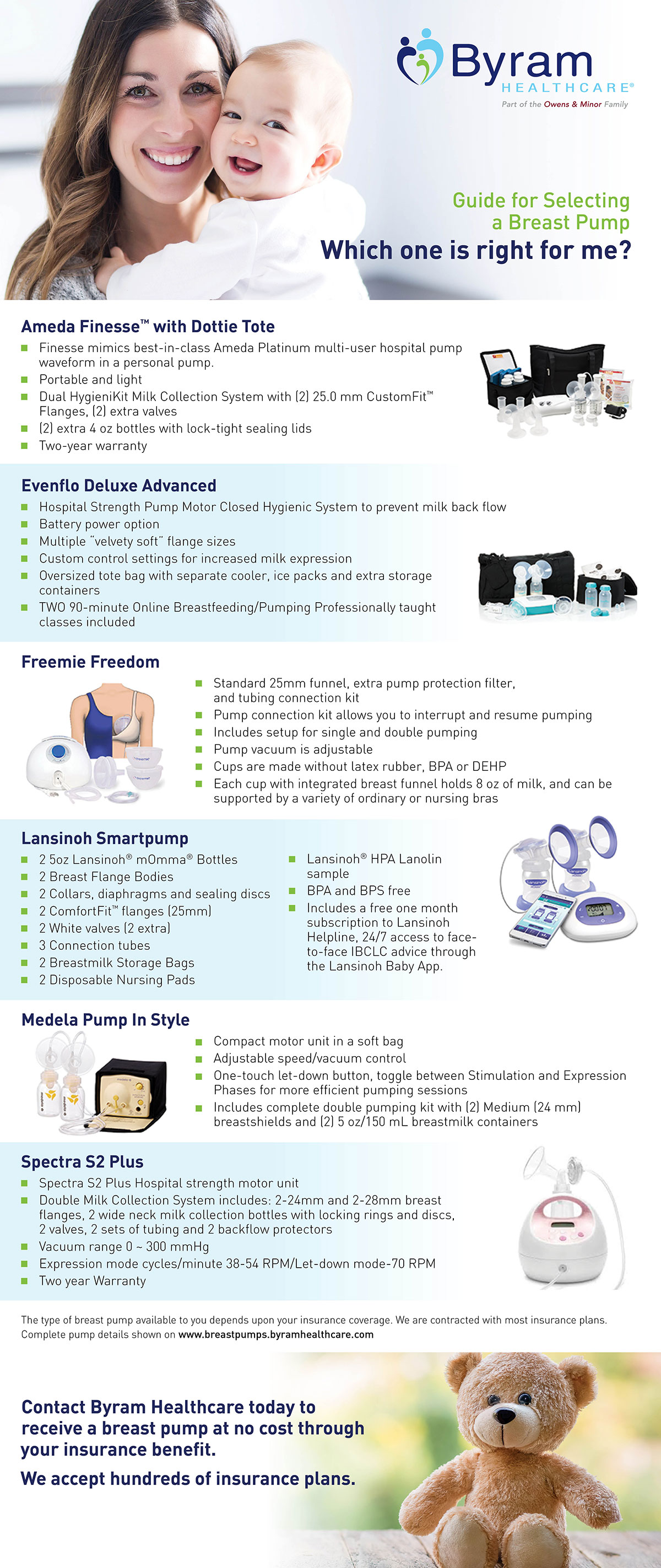Guide to Selecting a Breast Pump
One of the most confusing things about selecting a new breast pump is the overwhelming array of options that are available. You have manual pumps, electric pumps, hospital grade pumps and more. What’s more is that after you’ve narrowed that option down, there are still hundreds of different pumps in each category.
Since this ends up causing so much confusion and frustration for new moms, we wanted to help by giving you some clarification in how to narrow down your choices.
Check out the differences in pumps and read about some of our favorites below!
Types and Classifications of Pumps
There are a lot of different types of pumps, but many moms don’t fully understand what makes them different. While the difference between a manual and electric pump is pretty self-explained, there are still some details left to the unknown. That’s why it’s important to know exactly what the differences are and when each type of pump is recommended.
-
Manual pumps are recommended for mothers who tend to pump only once a day. They are also recommended for mothers who don’t expect to be separated from their baby for more than a short period of time. Manual pumps are more portable and more affordable than electric models. This makes them beneficial for mothers with limited insurance or those looking to purchase a second pump1.
Other women choose these pumps because they are simple and more “user friendly” than electric pumps. They also allow a greater range of control when it comes to the suction and pumping.
The only downfall to manual pumps is that they take much longer to use and, since your hand controls them, they are much more effort. If you are considering using a manual pump, try talking to a few other moms to get a better idea of what to expect.
-
These types of pumps are highly recommended for mothers who need to pump more than once a day. They deliver a convenience and efficiency that manual pumps can’t match. They are especially important for mothers who need to return to work full-time or are away from their newborns more frequently than they imagined.
Essentially, if you are unable to nurse your baby regularly, it is recommended that you purchase an electric breast pump.
Some of the reasons that we suggest this are that electric and battery-operated pumps are completely automatic. This means, when pumping frequently, you won’t tire out from manually having to operate the pump. They also have multiple setting options that help you adjust to variable cycling times and suction levels1.
There are even models available that mimic a baby’s sucking patterns: short, faster sucks followed by a much deeper and slower pattern1. This feature generally seems to make pumping more comfortable and helps reduce discomfort in your nipples.
A great benefit to electric or battery-operated pumps is that they are lightweight, extremely portable and usually come with cases and extra accessories. You can even add a nursing bustier to most models to make pumping hands-free1.
-
These are a type of electric pumps that come in handy for any moms that have trouble breastfeeding. If you have trouble during the first couple of weeks after your baby is born, or if you baby is not nursing enough to keep your milk supply flowing, then this is a great pump to use1.
These pumps are often stronger than a typical electric pump and are also recommended when you aren’t producing enough milk.
-
Open system pumps are pumps that do not contain a barrier between the tubes in the pump and the milk collection area2. This means that there is a small chance that your milk will leak into the pump, making it harder to clean and more inconvenient. The danger in this is that if you don’t notice any leakage, mold will develop. Luckily, manufacturers have noticed this and are beginning to switch to closed system pumps2.
-
A closed system pump has a diaphragm that essentially acts as a barrier between outside air and the inside tubes2. This barrier prevents any milk from leaking in, thus making it much more hygienic than open systems. It is also more convenient because this system means that you don’t need to wash or sterilize the tubes like you do in an open system2.
Manual
Electric or Battery-Operated
Hospital-Grade Breast Pumps
Open System
Closed System

Some General Tips
In general, there are some things to keep in mind when purchasing and using a pump. Check out our list to make sure you avoid these common mistakes.
-
Never get a used pump
It is unsanitary and will cause bacteria and viruses to transfer from one mother to another, which means one baby to another. In addition, they’re never as efficient as new ones and with the Affordable Care Act there is no reason to get a used pump.
-
When using one side of a double sided pump, seal the other side1
If you don’t block the exposed side, the pump will loose efficiency.
-
Get the right breast shields
Shields will come with your pump, but every nipple is different. If the ones provided are not the right size for you, make sure you purchase a new size that fits you. If you don’t, you will experience discomfort and less efficiency when pumping.
-
Clean your pump
It is important to clean your pump parts after each use, but not the tubing… unless breast milk gets inside1. Cleaning your tubing can cause more harm than not, especially if it is done too frequently or improperly. Just focus on the expendable parts of your pump and wash them with warm water and dish soap. If you’re confused about this, check your pump’s manual for model-specific insturctions1.
Different Models
While there are tons of different breast pumps on the market, the following are some of our favorites that you can get through Byram Healthcare. Just make sure to check with your insurance to see which ones are available to you at no cost.
Ameda Finesse™ with Dottie Tote
This breast pump is a closed-system, single-user pump designed with mothers in mind3. It provides a safe and effective way to pump and store milk. This double electric, hospital grade quality pump is portable, lightweight and convenient for moms who are always on the go. In addition, this pump comes equipped with:
- Dual HygieniKit Milk Collection System
- (2) 25.0 mm CustomFit™ Flanges
- (2) Extra valves
- (2) Extra 4ox bottles with lock-tight sealing lids
- Two-year warranty
Evenflo Deluxe Advanced
This is a great pump for any mother who needs to pump frequently. The design of the system helps to prevent milk back up in the tubing, which means a cleaner pumping system for you and your baby4. It is a hospital strength pump and comes with a battery-powered option. In addition, there are many different flange sizes and custom control settings. It also includes:
- An oversized tote bag
- Separate cooler, ice packs and extra storage
- (2) 90-minute Online Breastfeeding/Pumping Professionally taught classes
Freemie Freedom
The unique thing about the Freemie Freedom is that it allows you to pump with your shirt on5. It offers extra pump protection filters and a tubing connection kit for multi-functional uses. This allows you to stop and start pumping easily. This breast pump also includes:
- Latex, BPA and DEHP free cups
- Setup for single or double pumping
- Adjustable pump vacuum
- 8oz breast funnel in each cup that can be supported by a variety of bras
Lansinoh Smartpump
This breast pump actually comes equipped with Bluetooth® technology so that you can track each pumping sessions using the Lansinoh Baby App6. This helps to simplify your pumping routines and provides a ton of helpful data based on your history. Additionally, the pump comes with:
- (2) 5oz bottles
- (2) Breast flange bodies ad (2) ComfortFitTM flanges (25mm)
- (2) Collars, diaphragms and sealing discs
- (2) White valves
- (3) Connection tubes
- Storage bags and disposable nursing pads
Medela Pump In Style
This pump is great for mothers who need to pump several times a day. It involves a compact motor that is contained in a soft bag for easy transport and has adjustable speed and vacuum control. Some of the features include:
- One-touch let-down button
- Toggle between stimulation and expression phases
- Complete double pumping kit
- (2) Medium (24mm) breast shields
- (2) 5oz/150mL breast milk containers
Spectra S2 Plus
This breast pump is considered an extremely sophisticated pump. It has astonishingly adjustable settings, hospital strength and tons of fun extras like a nightlight and a timer7. It also includes:
- (2) 24mm and (2) 28mm breast flanges
- (2) Wide neck milk collection bottles with locking rings and discs
- Vacuum range from 0 – 300mmH
- Expression mode cycles/minute 38-54 RPM with Let-down mode of 70 RPM
- Two-year warranty
Conclusion
Breastfeeding is a difficult time in every mother’s life. If nothing is going right, it is stressful, discomforting and downright frustrating. That’s why choosing a breast pump is so important. Thanks to the Affordable Care Act, new mothers are eligible to receive an electric breast pump covered by their insurance provider. Depending on your insurance coverage and your individual needs, you are sure to find a pump that will help make your like easier. In addition, some insurance providers provide help from a latching consultant. Check with your provider and shop our selection at Byram Healthcare to find something that works for you.
If you have any experience with shopping for breast pumps and want to give a few words of encouragement, or suggestion, to our other new moms post on our Facebook page today!
SOURCES:
1https://www.babycenter.com/0_how-to-buy-a-breast-pump_429.bc
2http://www.breastpumpcomparisons.com/open-system-vs-closed-system-whats-the-difference.html
3
4https://www.evenflofeeding.com/products/breastfeeding/breast-pumps/deluxe-advanced-double-electric-breast-pump/
5http://www.freemie.com/freedom.html






